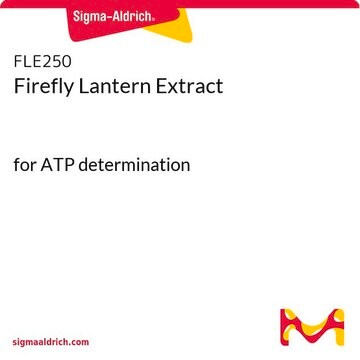L9420
Luciferase from Photinus pyralis (firefly)
recombinant, expressed in E. coli, buffered aqueous solution, ≥10×1010 units/mg protein
Sinónimos:
Luciferase firefly
About This Item
Productos recomendados
recombinant
expressed in E. coli
Quality Level
assay
≥98% (SDS-PAGE)
form
buffered aqueous solution
specific activity
≥10×1010 units/mg protein
mol wt
62 kDa
shipped in
dry ice
storage temp.
−20°C
¿Está buscando productos similares? Visita Guía de comparación de productos
General description
Application
Unit Definition
Unit Definition Conversion Factor: There are approximately 9000 Relative Light Units (RLU) per one traditional Light Unit that uses a peak height equivalent to 0.02 μCi of 14C in a PPO/POPOP cocktail.
Physical form
signalword
Danger
hcodes
Hazard Classifications
Acute Tox. 4 Oral - Resp. Sens. 1 - STOT RE 2 Oral
target_organs
Kidney
Storage Class
10 - Combustible liquids
wgk_germany
WGK 3
flash_point_f
231.8 °F
flash_point_c
111 °C
Certificados de análisis (COA)
Busque Certificados de análisis (COA) introduciendo el número de lote del producto. Los números de lote se encuentran en la etiqueta del producto después de las palabras «Lot» o «Batch»
¿Ya tiene este producto?
Encuentre la documentación para los productos que ha comprado recientemente en la Biblioteca de documentos.
Los clientes también vieron
Artículos
Bioluminescence imaging (BLI) systems allows for high-sensitive and noninvasive monitoring of cell proliferation, activity of signaling pathways and protein-protein interactions in living tissues.
seMpai substrate is suitable for near-infrared BLI in biological experiments, offering high solubility for extended bioluminescent applications.
seMpai substrate is suitable for near-infrared BLI in biological experiments, offering high solubility for extended bioluminescent applications.
seMpai substrate is suitable for near-infrared BLI in biological experiments, offering high solubility for extended bioluminescent applications.
Nuestro equipo de científicos tiene experiencia en todas las áreas de investigación: Ciencias de la vida, Ciencia de los materiales, Síntesis química, Cromatografía, Analítica y muchas otras.
Póngase en contacto con el Servicio técnico












